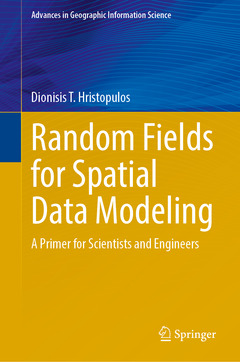Random Fields for Spatial Data Modeling, 1st ed. 2020 A Primer for Scientists and Engineers Advances in Geographic Information Science Series
Auteur : Hristopulos Dionissios T.

D. T. Hristopulos has more than 15 years of expertise in Geostatistics and mathematical modelling. His expertise includes the development of new geostatistical methods, algorithms for the simulation and interpolation of scattered data, analysis of mechanical properties and fracture of heterogeneous media, and applications of statistical physics in spatial analysis. In 2003 D. Hristopulos proposed a flexible and computationally efficient geostatistical model (Spartan Spatial Random Fields) with applications in automatic mapping of environmental processes and the simulation of geological spatial structures.
D. T. Hristopulos is on the editorial board of the journal Stochastic Environmental Research and Risk Assessment, published by Springer. He also participates on organizing committees of international conferences on statistics, geographic information systems (GIS) and statistical physics (e.g., statGIS 2006, 2007, 2009, Sigma Phi 2008, 2011, Interpore 2011). D. T. Hristopulos actively pursues innovative research in the framework of European projects. Research results are presented by him and his group in various conferences and seminars in Europe (e.g. European Geophysical Union Assemblies, GeoENV, etc) and the USA (e.g. Univ. of North Carolina, Johns Hopkins Univ., etc). T
Provides a bridge between statistical physics and spatial statistics and underlines links between geostatistics, applied mathematics and machine learning
Presents a unique approach, developed by the author, which has strong potential for fast and automated mapping of spatial processes
Includes several graphs and three-dimensional plots which help the readers to better understand the concepts
Date de parution : 02-2020
Ouvrage de 867 p.
15.5x23.5 cm
Thèmes de Random Fields for Spatial Data Modeling :
Mots-clés :
Conditional Simulation; Gaussian Statistical Field Theory; Local Interaction Models; Random Fields; Spatial Analysis of Natural Systems; Spatial Data Modelling; Spatial Random Field Theory; Spatial Statistics; Stochastics Differential Equations; data-driven science; modeling and theory building



